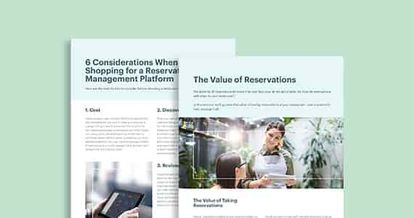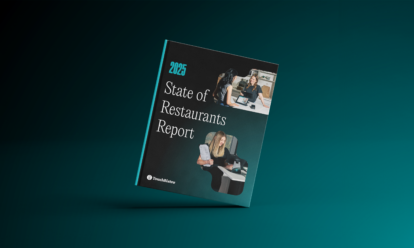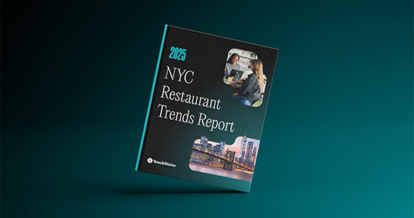A restaurant employee benefits program can help you attract new talent and hold onto the high-performing staff you already have. And in the midst of an ongoing labor shortage, it’s more important than ever to find ways to reduce staff turnover by giving employees the opportunity to have long-term and meaningful careers.
According to TouchBistro’s Labor Report, four in five operators say they are short at least one position. Servers and dishwashers were found to be the most in-demand roles, with a third of restaurants reporting they’re short on both roles. So why do employees leave? Often, they are seeking better pay, competitive restaurant benefits, and safer working conditions.
Without team members to fill your most important roles, service is deeply impacted. Dine-in guests wait longer for their orders and to be seated at tables, and takeout and delivery guests wait longer for food preparation and are more likely to face frequent order errors. All of this leads to a poor guest experience that can deter your customers from returning to your venue.
As a restaurateur, one of the best ways to create a great workplace is to provide a stable paycheck and restaurant benefits. Benefits like professional development opportunities, health insurance for restaurant workers, and transit stipends let your workers know you care about their long-term career and personal well-being, which ultimately makes them more likely to stick around.
In this complete guide, we’ll cover:
- Why do restaurants need to offer benefits?
- The different types of restaurant employee benefits
- The value of offering an employee benefits package
Why Do Restaurants Need to Offer Benefits?
Providing benefits is a great retention strategy because it shows employees that you care about their professional and personal well-being – both in the short-term and long-term. Additionally, giving your team a morale boost can lead to happier and more productive workers.
The benefits of working in a restaurant can also inspire and motivate employees to want to work at your business. That’s why you should make sure your benefits program reflects the values of your company culture and how you want your employees to be treated. This could make the difference in whether a candidate decides to apply to your restaurant or your competitors.
Types of Restaurant Employee Benefits

The following are different types of restaurant employee benefits you may choose to use for your restaurant.
Healthcare Benefits
Health insurance for restaurant employees is among the most common type of benefits. Below are a few examples of what your healthcare coverage could look like:
Healthcare Insurance
If you can’t afford to raise wages, one of the biggest retention strategies in the restaurant industry today is to provide health insurance for restaurant employees. In the hospitality industry, turnover is notoriously high, with restaurant workers changing jobs every 56 days, according to 7shifts. Rather than losing employees to competitors, healthcare incentives can encourage your best team members to stick around and perform to their best ability.
According to the Affordable Care Act, restaurants in the U.S. with less than 50 full-time or full-time equivalent employees aren’t required to offer health insurance for restaurant employees. Whether you are obligated or not, offering a group health plan can help increase retention and loyalty by letting your employees know you care about their long-term well-being. Plus, providing your team with access to the medical support they need may lead to fewer staff absences and sick days.
Mental Health and Wellness
With long hours and shifts, restaurant workers can experience depression, sleep problems, and stress. That’s why providing mental health and wellness resources can be very beneficial to help improve employee attentiveness and prevent burnout.
Here are a few ways you can provide health resources to your staff:
- Provide subscriptions to mental health apps like Moodfit, Talkspace, or Calm
- Give staff a stipend to spend on therapy, like seeing a psychotherapist or social worker
- Host workshops on wellness topics, like how to eat better or how to reduce stress
- Offer discounts to fitness gym memberships, cardio classes, or yoga sessions
- Provide resources to restaurant mental health associations like Restaurant After Hours
- Offer sick days and paid time off that can be used for mental health concerns
Professional Training and Personal Development

Opportunities for employees, whether they are a general manager or a restaurant busser to grow their skillset and advance their careers are more reasons why prospective talent might choose to work at your restaurant and stay. And yet, only 39% of restaurants report investing in professional development opportunities to stay competitive, according to TouchBistro research. While restaurant roles may feel temporary due to the industry’s high turnover rate, 7shifts found that employees actually do want long-term career prospects. Furthermore, 33% of restaurant workers reported that they would like to see manager recognition come in the form of promotions.
Upward mobility and recognition acknowledges your employees’ talents and plays to their strengths. One way to achieve employee recognition is by giving top performers the chance to take on leadership roles. For example, you could let a veteran chef train new staff, or encourage your back-of-house team to contribute ideas on how to reorganize the kitchen for maximum efficiency.
Here are ways to help your employees grow at your restaurant, both professionally and personally:
Professional Training
Restaurants that have good orientation programs get new employees up to speed faster, which can result in lower turnover rates. Additionally, orientation shows that a restaurant values its employees, and is ready to provide the tools necessary for success on the job. Here are a few training platforms you can leverage:
- DiscoverLink is an accessible e-learning platform for the hospitality industry.
- ServSafe offers food and alcohol safety training and certification exams.
- LinkedIn Learning offers a variety of online training for business and service skills.
Team Building
Teamwork helps build motivation, making workers more productive and ultimately boosting your bottom line. Without proper teamwork, poor service can instead lead to fewer customers. According to research by Gallup, having an engaged team can increase customer rating by 10% and sales by 20%.
Consider hosting informal social events, encouraging open communication, and collecting feedback from everyone on the team. When employees see you are taking your workplace culture seriously, they will feel more valued and trusted.
Employee Rewards
Incentives will help your restaurant staff feel excited about their work, therefore increasing employee engagement. You can provide attendance-based cash rewards for employees who have few call-ins or absences. Alternatively, you can reward employees based on performance, like the number of tables they cover in a month, or total sales.
To gauge workplace performance, you can use a restaurant employee evaluation form. And remember to arrange extra training sessions for anyone who isn’t performing well.
Work/Life Balance

Working around the clock creates stress, resulting in lower productivity and disengagement. Employees need rest and giving them time to recuperate will make it easier to ask for extra hours when it’s really necessary, like during the busy holiday rush in December. If you decide to offer Paid Time Off (PTO) or Volunteer Days as part of your employee compensation package, make sure to also include it in your restaurant employment contract. It can be a deciding factor on whether someone decides to accept or pass on working at your restaurant!
Paid Time Off
Though not always required by law, paid time off can help employees feel appreciated, treated well, and overall happier. When creating your PTO policy, you’ll need to think about how many vacation days and sick days you will offer. You can also create policies for how far in advance employees should request PTO and when an employee becomes eligible for taking time off after being hired.
Volunteer Days
Giving back to the community is another way to remain competitive as an employer and to make your restaurant a great place to work. Volunteer days allow employees to use their PTO during work hours to help a cause that they care about.
Compensation
Restaurants are still working to recover from revenue losses incurred during the pandemic, making it challenging to increase compensation.
However, it’s important to keep in mind that total compensation doesn’t have to mean just an hourly wage or annual salary. To remain competitive, a multifaceted approach is essential. Here are some additional ways that your restaurant can provide a competitive compensation package:
Bonuses
Bonuses show your staff they are appreciated and motivate them to show up on time. As 7Shifts found, higher wages are one of the top demands among restaurant workers. In fact, participants ranked a pay increase as the number one thing that would make them feel more engaged at work. And when it comes to manager recognition, a whopping 69.5% of respondents said they’d like for that to come in the form of paid bonuses.
Free Meals
When prospective employees are looking for a job, they are looking for more than just an income, but a place that will make them happy. And we all know that free food makes people happy. Employees appreciate a nice break for a meal, plus letting them try the menu will help them learn it better – it’s a win-win situation. For example, Chipotle offers free burritos to their staff and 50% off when they are not working.
Profit-Sharing
Profit-sharing awards employees a percentage of your restaurant’s profits. The amount of money that you give employees is based on a specific timeframe, such as every quarter. This method is less risky than bonuses because the cost is proportionate to total revenue, so you don’t have to worry about paying too much or little. It also creates unity among staff as everyone works together towards the common goal of making your restaurant successful.
Childcare
The restaurant industry has unpredictable schedules, and childcare can be difficult to coordinate and pay for without support. On average, families across the U.S. spend $8,355 a year on child care for each kid, which can impact parents’ household budgets and their ability to work productively. Contributing towards the cost of your employees’ childcare will help relieve your staff’s stress levels, plus with peace of mind, they will likely become more attentive to their work.
Transportation
Did you know that the average one-way commute in America is approximately 28 minutes each way? Additionally, 23% of workers in the U.S. have quit a job because of a tough commute, according to a Robert Half Survey, while 85% would be willing to take a pay cut for a shorter commute.
While you can’t cut your staff’s commute time, you can try to make it easier for them to pay expenses with perks like free parking, discounted public transit passes, or bike storage areas. Also, employees can be much more efficient and improve productivity when they don’t have to factor in commuting logistics and costs into their work routines.
Understanding the ins and outs of restaurant employee benefits are great, but implementing them and sharing them is even better. When prospective employees are searching for work, they may be looking for the benefits of working in a restaurant. A comprehensive benefits program can play a vital role in attracting and retaining top talent, as well as reducing turnover and its costs.
Remember to also include your benefits in your restaurant employee handbook so they are always top of mind. After all, it’s much easier to retain quality employees than to spend countless hours recruiting, training, and finding replacements. Keeping employees happy will also help increase engagement in the workplace, and can boost productivity and sales.
Even if you already offer health insurance for restaurant workers, there is always room to improve your benefits program, and the return on investment is guaranteed to be worth your time.
Download your free employee handbook template
Sign up for our free weekly TouchBistro Newsletter







